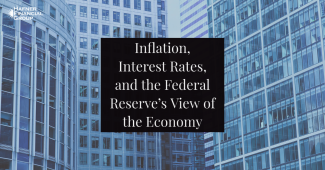
Inflation, Interest Rates, and the Federal Reserve’s View of the Economy
Despite stocks and real estate values climbing to record highs and the economy beginning to rebound from its plummet many are feeling the effects of a fractured economy. Perhaps the biggest is the numerous delays and shortages in supplies felt all across numerous industries as cargo ships remained parked with nowhere left for their freight to go. Although many predicted the long-term effects stimulus checks would have on the money supply, few are aware of just how much the money supply has increased. In the past year alone the money supply has quintupled and congress is currently in talks of printing even more. With many continuing to feel the effects of their money not stretching far enough the Federal Reserve has stepped forward to unveil its plan to help mitigate anxiety.
Last September, Jerome Powell chairman of the Federal Reserve unveiled their plan to begin exiting their emergency plan and address inflation concerns. Although he stated that inflation has grown above the Fed’s goal of 2% he viewed it as a temporary phenomenon and that any action taken to help curb inflation rates could begin to set in after the effects have already passed. This has done little to curb some anxiety over the amount of money in circulation as some analysts have warned of a possible bubble in the stock market. Due to the rapid increase in supply certain stocks have soared well above their actual value because inflation tends to follow where money is being spent this could lead to an eventual snap where investors are unable to make significant returns even if the value of a stock has steadily increased.
The other piece of news to come out of the recent conference in Jackson Hole is that the Federal Reserve has announced its plan to slowly back out of QE or quantitative easing. The Fed often employs this technique as an emergency strategy to keep the economy afloat and has been the significant factor behind the record low-interest rates. In order to keep faith in the economy the Federal Reserve purchases securities in treasuries and mortgages. This creates the effect of keeping interest rates low and borrowing cheaper. Numerous different companies have taken advantage of these record low interest rates and have either expanded or kept their businesses afloat during these troubling times. Low-interest rates also have the additional effect of increasing the value of bonds but this increase in value could end soon if the Federal Reserve does indeed back out of QE.
Yet what does this all mean for the future of the economy? Although the Federal Reserve sees inflation as a temporary phenomenon not to really worry about in the long term many fear that not taking immediate action to curb the effects could have dire consequences if it reaches a point where it could no longer be easily maintained. Despite the Federal Reserve’s promise to slowly back out of QE, some analysts view a rise in interest rates as a natural consequence of a higher money supply as inflation follows where money is being spent. Though some may trust what the Federal Reserve says and have faith in its strategy others fear that inflation will soon be felt over the entire financial spectrum. Time will tell whether either side is correct or if the economy takes another direction entirely.
The economic forecasts set forth in this material may not develop as predicted and there can be no guarantee that strategies promoted will be successful.

